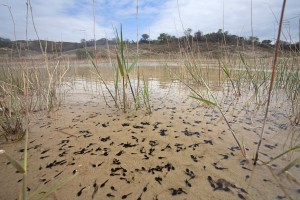Environmental DNA (eDNA) refers to DNA that can be extracted from environmental samples, such as water, soil or faeces, without first isolating any target organisms.
Origins of environmental DNA
 All living organisms, regardless of their size or ecology, leave traces of DNA in their environments, reflecting their current or past presence. This DNA can be released into the environment through faeces, urine, gametes, mucus, etc. It can also result from the decomposition of dead organisms. eDNA is characterized by a complex mixture of nuclear, mitochondrial or chloroplast DNA, and can be intracellular (from living cells) or extracellular. It enables the detection of a species regardless of its life stage or gender.
All living organisms, regardless of their size or ecology, leave traces of DNA in their environments, reflecting their current or past presence. This DNA can be released into the environment through faeces, urine, gametes, mucus, etc. It can also result from the decomposition of dead organisms. eDNA is characterized by a complex mixture of nuclear, mitochondrial or chloroplast DNA, and can be intracellular (from living cells) or extracellular. It enables the detection of a species regardless of its life stage or gender.
Persistence of environmental DNA
Once released in the environment, DNA can be degraded by biotic (bacteria, fungi, endonucleases, etc.) and abiotic factors (UV radiation, acidity, temperature, etc.), or persist in the environment, adsorbed on organic or inorganic particles. In general, cold and dry conditions slow down eDNA degradation. For example, in permafrost, eDNA can be stored for hundreds of thousands of years. In contemporary soils or in lacustrine or marine sediments, the persistence of eDNA varies from months to thousands of years depending on environmental conditions. In aquatic environments, the DNA released by an organism can be detected for only a few days.
For more information, you can download: Dejean et al. 2011.pdf.
Limits of environmental DNA approaches

Most of eDNA analyses developed to date, target short fragments of mitochondrial DNA (mtDNA). Indeed, every eukaryotic cell usually has two copies of nuclear DNA and hundreds or thousands of copies of mitochondrial DNA. This large number of mtDNA copies allows optimising the detection of species from environmental samples. However, except in rare cases, mtDNA is maternally inherited, which prevents the identification of hybrids. By analysing eDNA, it is not possible either to distinguish individuals of the same species (or in some cases genetically similar species) or to acquire information such as the number of individuals present on a site, their age, class, size, sex, etc.

